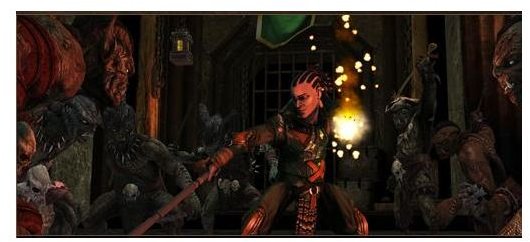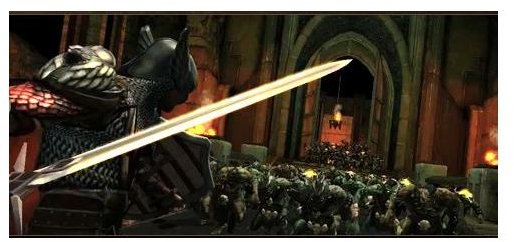XBLA Game Review: D&D Daggerdale

Life In Daggerdale: Gameplay (4 out of 5)
Daggerdale plays like a fairly standard dungeon crawler. This is largely due to the fact that Dungeons & Dragons plays like a fairly standard dungeon crawler and is in fact one of the primary influences for most of that genre of games. Gameplay is made up of moving from area to area, occasionally collecting a quest or two from an NPC or stopping at a merchant to buy some new equipment, and then moving on, from one swarm of monsters to the next, killing everything in your path and looting any new equipment you can find along the way. It’s an old formula, and a simple one, but it’s one that works because of its simplicity. It makes it something that’s easy to pick up and just as easy to put down. It’s not a game you’ll get lost in for hours and hours on end the way you might with some of the story-heavy RPGs available, but it is the game you’ll play when you have an hour to kill and don’t have time for the investment that those games can be.
Character selection at the beginning lacks customization, which is unfortunate. I understand that they wanted to make it easy for people to jump into, but one of the best parts of D&D is making your characters, and instead of choosing a race and class and setting all your traits, there are four characters to choose from. An elf rogue, a dwarf cleric, a human fighter, and a halfling wizard. The game will generate a default name for them, which, in addition to a couple of points you’re given to spend on feats and powers, is the only thing you can actually customize yourself if you wish.
Moving Around In The Dales: Controls (4 out of 5)
The controls in Daggerdale are pretty simple, and borrow heavily from the current crop of console RPGs. Both your items and your skills, from your basic attacks to the special skills you learn as you level up, can be assigned to the four main buttons on the controller (A, B, X, and Y.), and by holding down one the LT shoulder button, you can bring up a secondary set of four more skills assigned to the same buttons, giving you a total of eight quick keys. The Y button is assigned as the button to interact with objects such as switches or treasure chests, so it’s really seven keys, but for a simple hack-and-slash dungeon crawler, that’s still more than enough for the number of skills you’re going to end up with. Each of the four playable characters also has one unique default ability which can be used by pressing the RB shoulder button. Since the gameplay is relatively simple, the controls are simple by design. They’re intuitive, however, and they respond in the way they should without causing issues.
My only complaint with the controls is that, in combat, the game auto-targets the enemy in your line of sight, which can change rapidly since the enemies are always moving to rush at you. You can lock a specific target using the RT shoulder button, but it’s the one area where the controls are not as intuitive as they could be. This can cause problems, especially with ranged combat.
That’s a Lot of Goblins: Graphics (3 out of 5)

The graphics in Daggerdale are obviously not going to match up to the full-priced console releases, because that’s not what this is. However, for an arcade game, the graphics are really quite impressive. When talking to NPCs, you’ll notice some facial expressions, which is always a nice touch. For practical reasons, the NPCs tend to look alike, as do the monsters, but the four playable characters are all quite unique. As well, when you change your equipment, your character’s equipment will change in the game, and a lot of the loot is actually relatively unique so that it really does make a difference. Environments are re-used as well, but they look quite good and they do a good job in creating the atmosphere that lends itself to the Dungeons and Dragons feel of the game as a whole.
The Sweet Sounds of Swordfighting: Audio (5 out of 5)
The sound effects are nothing you haven’t heard before. I swear there’s a shared file folder somewhere that all video game developers are allowed to take combat sound effects from, because every hack-and-slash game seems to sound almost exactly the same. This means that they’re not actually a bad thing; they’re just not an exceptionally good thing either. They get their job done, but there’s nothing especially surprising or unique about them. The music, however, is actually quite good. It’s atmospheric, and the tonal changes and changes in tempo are well-matched to the action going on around you. Atmosphere and mood is something that the developers achieved quite well, and the music is a big part of that.
There is a small amount of voice acting in cutscenes as well, and it’s actually surprisingly solid for a downloadable arcade game. It’s a small thing, but it’s another thing that’s a big part of the game’s successful atmosphere.
Two Warriors Are Better Than One: Co-op Play (4 out of 5)

The game offers both local and online co-op play, though it’s not true co-op in the sense that both players can run a campaign together. Instead, the player hosting the game plays their single player campaign, and the other player just helps them with their quests. You are able to keep any loot you pick up and any experience you gain while playing your character in another person’s game, however.
The co-op works pretty well. I experienced no lag, and the game shifts pretty seamlessly to account for the extra player. Enemies change in level and amount to match the combined strength of the party, and experience and gold picked up is shared among players, while the loot goes to whomever gets there first. There’s also an added ability to revive fallen allies by simply pressing the Y button. It can be used an infinite number of times, and this helps to keep the action moving, especially if one of the players is a few levels lower than the other. There is a timer in which you can use the revive skill to stop it from making things too easy, but overall it’s a good way to keep things fast-paced.
Does It Live Up To The D&D Name? (4 out of 5)
Daggerdale is definitely successful as a dungeon crawler and as a hack-and-slash action game. It’s got plenty of quests and plenty of loot to keep you busy, and combat is fast-paced and a lot of fun. The environments are well-designed and even if they are a little bit graphically repetitive sometimes, they’re varied enough to be as interesting as they need to be.
As a D&D game, however, I’m not sure it succeeds quite as much. It does do a good job with atmosphere, visually and especially through the audio, in creating something that feels like a Dungeons & Dragons campaign. Unfortunately, it feels like playing someone else’s D&D campaign for them, since you’re not involved in customizing the experience at all. In not allowing you to customize your own character, it falls a little short of the mark, and in failing to include more than four classes or races, it falls well short of the mark. Quite simply, this isn’t D&D.
D&D: Daggerdale is available for PC and XBOX Live Arcade, and will be released on PSN in the near future. If you’re looking for a uniquely Dungeons & Dragons experience, keep looking, because this game isn’t D&D. It’s just a game that feels just enough like D&D to make you wish for more. If, however, all you’re looking for is a fun hack-and-slash dungeon crawler, this game delivers, and is easily worth the price of the download. I’m certainly not unhappy I bought it; it just could have been so much more.
References
Source: Author’s Own Experience.
Images: From Official Game Website, https://www.atari.com/daggerdale
